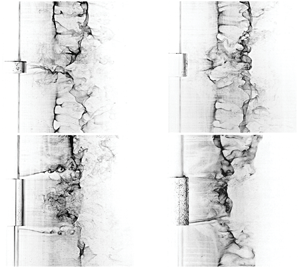Crossref Citations
This article has been cited by the following publications. This list is generated based on data provided by
Crossref.
Yan, Yuhao
Ji, Chunning
and
Srinil, Narakorn
2020.
Three-dimensional flip-flopping flow around a pair of dual-stepped circular cylinders in a side-by-side arrangement.
Physics of Fluids,
Vol. 32,
Issue. 12,
Abdelhady, Mohamed
and
Wood, David H.
2021.
Studying the flow dynamics and heat transfer of stranded conductor cables using large eddy simulations.
Physics of Fluids,
Vol. 33,
Issue. 1,
Abdelhady, Mohamed
and
Wood, David H.
2021.
An investigation of the wakes of stranded cables using particle image velocimetry.
Physics of Fluids,
Vol. 33,
Issue. 3,
Yan, Yuhao
Ji, Chunning
and
Srinil, Narakorn
2021.
On wake modulation and interaction features of a pair of dual-step circular cylinders in side-by-side arrangements.
Physics of Fluids,
Vol. 33,
Issue. 9,
Tian, Cai
Jiang, Fengjian
Pettersen, Bjørnar
and
Andersson, Helge I.
2021.
Vortex system around a step cylinder in a turbulent flow field.
Physics of Fluids,
Vol. 33,
Issue. 4,
Reddy, D Siva Krishna
Kumar, Pankaj
Makhija, Jai
Pasha, Amjad Ali
and
Hameed, Abdul Zubar
2021.
CFD of Flow Dynamic and Heat Transfer Characteristics of Dual Step Cylinders at Re = 2100.
Arabian Journal for Science and Engineering,
Vol. 46,
Issue. 12,
p.
12667.
Forouzi Feshalami, Behzad
He, Shuisheng
Scarano, Fulvio
Gan, Lian
and
Morton, Chris
2022.
A review of experiments on stationary bluff body wakes.
Physics of Fluids,
Vol. 34,
Issue. 1,
Tian, Cai
Zhu, Jianxun
Holmedal, Lars Erik
Andersson, Helge I.
Jiang, Fengjian
and
Pettersen, Bjørnar
2023.
How vortex dynamics affects the structural load in step cylinder flow.
Journal of Fluid Mechanics,
Vol. 972,
Issue. ,
Hayden, Andrew P.
Hefner, Cole
Gillespie, John
Untaroiu, Alexandrina
and
Lowe, Todd
2023.
A Computational and Experimental Analysis of Vortex Shedding from Complex Turning Vanes.
Panesar, Simran Singh
Xia, Hao
and
Passmore, Martin
2023.
Oblique and parallel modes of the bistable bluff body wake.
Physical Review Fluids,
Vol. 8,
Issue. 8,
Burgaard, Karen B.
Carstensen, Stefan
Fuhrman, David R.
Larsen, Bjarke E.
and
O’Neill, Finbarr G.
2023.
Experimental and numerical investigation of a disc-attached cylinder near a wall.
Ocean Engineering,
Vol. 285,
Issue. ,
p.
115366.
Theja, Charan
Sathia, Kishore Ram
Mahesh, Somasani
and
Narasimhamurthy, Vagesh D.
2024.
Large eddy simulation of turbulent wake from dual-step cylinders.
Physics of Fluids,
Vol. 36,
Issue. 10,
Bulbule, Shreyas
Kumar, Pankaj
and
Singh, Santosh Kumar
2024.
Investigation of wake dynamics near the cylinder with the variation of length-to-diameter ratio.
Physics of Fluids,
Vol. 36,
Issue. 8,
Hayden, Andrew P.
Gillespie, John
Hefner, Cole
Lowe, K. Todd
and
Untaroiu, Alexandrina
2025.
Wake Dynamics of Complex Turning Vanes Using Time-Resolved Particle Image Velocimetry Measurements.
Journal of Fluids Engineering,
Vol. 147,
Issue. 1,
Gong, Ying
Peng, Qianyi
Shen, Fan
and
Wang, Biao
2025.
Interfacial properties of mechanical elements on vortex shedding: Roughness and hydrophilicity.
Physics of Fluids,
Vol. 37,
Issue. 3,
Tian, Cai
Zhu, Jianxun
Andersson, Helge I.
Pettersen, Bjørnar
and
Holmedal, Lars Erik
2025.
Laminar flow over I-shaped dual-step cylinders.
Journal of Fluid Mechanics,
Vol. 1004,
Issue. ,

 $D$) attached coaxially to the mid-span of a small diameter cylinder (
$D$) attached coaxially to the mid-span of a small diameter cylinder ( $d$). This work provides a comprehensive description of the flow development, classifies common wake regimes and considers the associated structural loading on a dual-step cylinder. The influence of the aspect ratio of the large diameter cylinder (
$d$). This work provides a comprehensive description of the flow development, classifies common wake regimes and considers the associated structural loading on a dual-step cylinder. The influence of the aspect ratio of the large diameter cylinder ( $L/D$) and diameter ratio (
$L/D$) and diameter ratio ( $D/d$) is studied experimentally for a Reynolds number of
$D/d$) is studied experimentally for a Reynolds number of  $Re_D = 2100$,
$Re_D = 2100$,  $1.33\leq D/d \leq 4$ and
$1.33\leq D/d \leq 4$ and  $0.2\leq L/D \leq 5$. The flow evolution and structural loading are quantified via a combination of flow visualization, Laser Doppler velocimetry, particle image velocimetry measurements and multi-component force balance measurements. Through a detailed analysis of the results, six distinct flow regimes are identified based on observed changes in the flow development downstream of the large diameter cylinder. The findings are distilled into a map of flow regimes that provides a framework for analysis of the dual-step cylinder wakes and incorporates limiting cases of this geometry, namely, uniform circular cylinders, cantilevered cylinders, cylinders with two free ends, coin-like cylinders and single-step cylinders. The identified flow regimes are also related to changes in structural loading.
$0.2\leq L/D \leq 5$. The flow evolution and structural loading are quantified via a combination of flow visualization, Laser Doppler velocimetry, particle image velocimetry measurements and multi-component force balance measurements. Through a detailed analysis of the results, six distinct flow regimes are identified based on observed changes in the flow development downstream of the large diameter cylinder. The findings are distilled into a map of flow regimes that provides a framework for analysis of the dual-step cylinder wakes and incorporates limiting cases of this geometry, namely, uniform circular cylinders, cantilevered cylinders, cylinders with two free ends, coin-like cylinders and single-step cylinders. The identified flow regimes are also related to changes in structural loading.